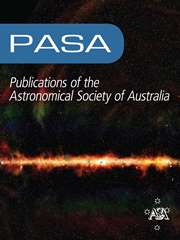No CrossRef data available.
Article contents
X-ray and CO-Derived Column Densities in AGN: A Study of Obscuration Properties in CTAGN and Non-CTAGN
Published online by Cambridge University Press: 01 April 2025
Abstract
Obscuration in active galactic nuclei (AGN) provides valuable insights into the nature of the material surrounding the central engine. Comptonthick AGN (CTAGN), characterised by a column density of NH ≥ 1.5 × 1024 cm−2, are heavily obscured by substantial amounts of dust and gas. While X-ray observations are primarily used to determine this column density, our understanding of obscuration properties in the sub-mm regime, particularly for CTAGN, remains limited. In this study, we analyse archival data from the Atacama Large Millimetre/sub-millimetre Array (ALMA) for both CTAGN and non-CTAGN sources, as identified by the 70-month catalogue of the all-sky hard X-ray Swift/Burst Alert Monitor survey and other X-ray surveys. Integrated intensity maps (moment 0) of CO(3–2) emission reveal a concentrated distribution of dense gas around the nucleus. Utilising a constant CO-to-H2 conversion factor, XCO = 2.2 × 1020 cm−2 (K km s−1)−1, we find that the derived molecular hydrogen column densities, NH2, are generally lower than the total hydrogen column densities, NH, obtained from X-ray observations. However, the NH2 values derived in this work are slightly higher than those reported in previous studies due to the adoption of a higher CO-to-H2 conversion factor. This discrepancy between NH and NH2 is consistent with prior findings that X-ray-derived column densities are typically higher, except in the case of non-CTAGN, where NH2 can exceed NH. Statistical analysis using Kendall and Spearman tests reveals a positive monotonic relationship between NH and NH2, although the correlation is not statistically significant. This suggests a complex interplay of factors influencing these properties. The optically thick nature of CO in dense regions may contribute to the observed discrepancies. Our results highlight the importance of adopting an accurate CO-to-H2 conversion factor to derive reliable column densities, which could serve as an alternative method for identifying CTAGN. Further investigations with more comprehensive data sets and refined methodologies are needed to better understand the relationship between sub-millimetre and X-ray properties in AGNs.
Keywords
- Type
- Research Article
- Information
- Creative Commons
- This is an Open Access article, distributed under the terms of the Creative Commons Attribution licence (https://creativecommons.org/licenses/by/4.0/), which permits unrestricted re-use, distribution and reproduction, provided the original article is properly cited.
- Copyright
- © The Author(s), 2025. Published by Cambridge University Press on behalf of Astronomical Society of Australia


